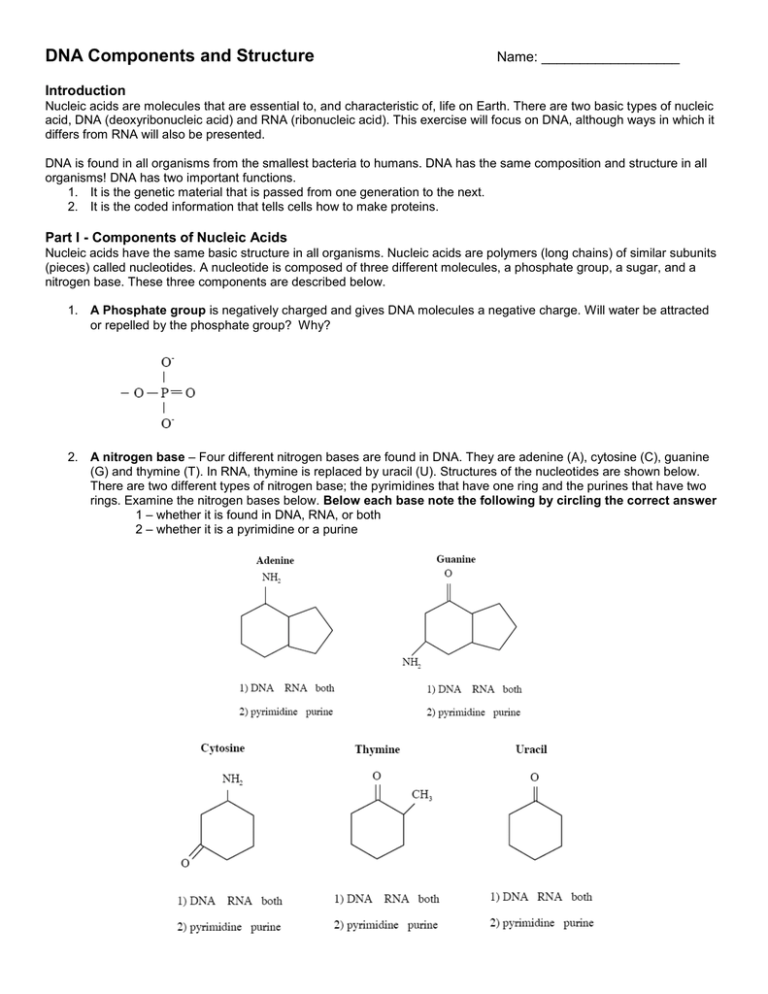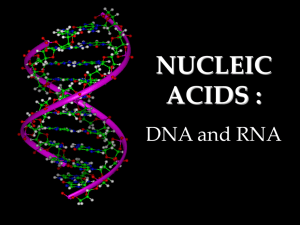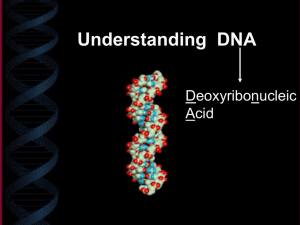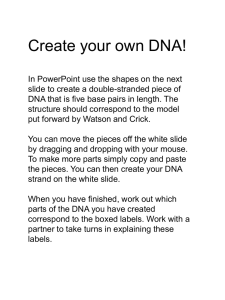DNA Components and Structure Name: __________________ Introduction
advertisement

DNA Components and Structure Name: __________________ Introduction Nucleic acids are molecules that are essential to, and characteristic of, life on Earth. There are two basic types of nucleic acid, DNA (deoxyribonucleic acid) and RNA (ribonucleic acid). This exercise will focus on DNA, although ways in which it differs from RNA will also be presented. DNA is found in all organisms from the smallest bacteria to humans. DNA has the same composition and structure in all organisms! DNA has two important functions. 1. It is the genetic material that is passed from one generation to the next. 2. It is the coded information that tells cells how to make proteins. Part I - Components of Nucleic Acids Nucleic acids have the same basic structure in all organisms. Nucleic acids are polymers (long chains) of similar subunits (pieces) called nucleotides. A nucleotide is composed of three different molecules, a phosphate group, a sugar, and a nitrogen base. These three components are described below. 1. A Phosphate group is negatively charged and gives DNA molecules a negative charge. Will water be attracted or repelled by the phosphate group? Why? 2. A nitrogen base – Four different nitrogen bases are found in DNA. They are adenine (A), cytosine (C), guanine (G) and thymine (T). In RNA, thymine is replaced by uracil (U). Structures of the nucleotides are shown below. There are two different types of nitrogen base; the pyrimidines that have one ring and the purines that have two rings. Examine the nitrogen bases below. Below each base note the following by circling the correct answer 1 – whether it is found in DNA, RNA, or both 2 – whether it is a pyrimidine or a purine 3. A 5 carbon sugar. Both DNA and RNA contain a 5 carbon sugar. Sugars are molecules made up of carbon, hydrogen and oxygen with molecular formulas that are usually some multiple of CH2O. In DNA, the sugars are closed to form ring structures. DNA contains the 5 carbon sugar deoxyribose (hence the name deoxyribonucleic acid) whereas RNA contains ribose (ribonucleic acid). The deoxy prefix refers to the fact that deoxyribose is missing one of the oxygens (represented by the letter O) found in ribose. Examine the two sugars below. Note that the carbons (represented by the letter C) are numbered. At which carbon is deoxyribose lacking an oxygen? Part II - Building a nucleotide The basic building block of DNA and RNA is the nucleotide. Above you learned the components of a nucleotide. In this step, you will put these components together to form a nucleotide. The sugar is the central component of the nucleotide. The phosphate is attached to the number 5 carbon of the sugar. The nitrogen base is attached to the number 1 carbon of the sugar. Use the following symbols and the description above in to construct a schematic drawing of a nucleotide. Use short lines to attach the components to each other. Part III - Building a polymer DNA and RNA are polymers. Polymers are long chains of similar units. In both DNA and RNA the unit is the nucleotide. Nucleotides are joined together into a polymer string by joining the phosphate group of one nucleotide, to the number 3 carbon of the next sugar. In this step, you will assemble a polymer using nucleotide monomers. Using the same symbols you used before, draw a chain that is three nucleotides long. Part IV – Double stranded vs single stranded RNA is a single strand of nucleotides like what you drew above. DNA, however, is double stranded (ds), meaning there are two of the above strands together. The two strands are held together by bonds, called hydrogen bonds, between the nitrogen bases. Assemble a double stranded DNA molecule with sugar phosphate backbones on the outside, and nitrogen bases on the inside. Use the chain of bases on the following page as one strand and tape in the other strand. Observe the following rules when constructing your DNA molecule. Allow no overlap between the nucleotides. The hydrogen bonds, represented by the dotted lines, must line up. Form a continuous strand – the sugar/phosphate backbone should have no breaks and should resemble that of the first strand Label: o Adenine o Thymine o 5’ end o Guanine o Deoxyribose o 3’ end o Cytosine o Phosphate group



